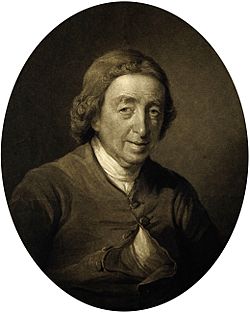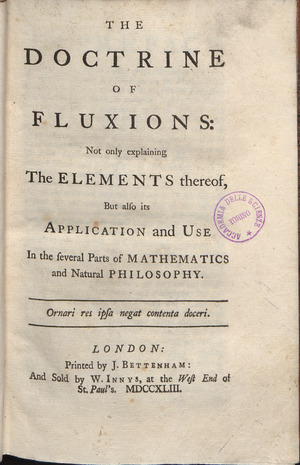William Emerson (mathematician) facts for kids
Quick facts for kids
William Emerson
|
|
|---|---|
 |
|
| Born | 14 May 1701 Hurworth
|
| Died | 20 May 1782 (aged 81) |
| Nationality | British |
| Scientific career | |
| Fields | mathematics |
William Emerson (born May 14, 1701 – died May 20, 1782) was a very smart English mathematician. He was born in a place called Hurworth, which is near Darlington. His father, Dudley Emerson, was also a mathematician and taught at a school there.
Contents
William Emerson's Life
William Emerson owned a small piece of land in Weardale called Castle Gate. It was close to Eastgate. He would go there during the summer to work on many different projects. These projects included things like stonemasonry (working with stone) and even watchmaking.
He wasn't very successful as a teacher. So, he decided to spend all his time studying and working on his own. William was known for being full of energy and speaking his mind directly. He published many books, and they were known for having very few mistakes.
How Emerson Tested His Ideas
In his book The Principles of Mechanics (published in 1754), William Emerson described a vehicle that moved using wind power. This vehicle had a propeller that spun vertically. The propeller then directly powered the front wheels through a system of gears.
Emerson had a special way of working. In the field of mechanics (the study of how things move), he never suggested an idea unless he had already tested it himself. He also never published an invention without first building a small model to show how it worked.
He was also very skilled in the science of music. He understood the theory of sounds and how different musical scales worked, both old and new. However, he was not a great musician himself.
Emerson's Later Years
William Emerson passed away on May 20, 1782, in his hometown. His gravestone there has special messages written in Latin and Hebrew.
Emerson had a unique style. He often wore old clothes. He was once offered a chance to join a famous science group called the FRS (Fellow of the Royal Society). But he turned it down. He said it would cost too much money, especially after all the money he had spent on candles for his studies over the years!
In his older years, William Emerson had some health problems. He would sometimes pray and sometimes complain about his pain. He wished his soul could leave his body without such a struggle.
William Emerson is even mentioned in a book called Mason and Dixon by Thomas Pynchon. Another smart person from his area, John Bird, also appears in that book.
William Emerson's Works
William Emerson wrote many important books. Here are some of them:
- The Doctrine of Fluxions (1748); 3rd edition (1768)
- The Projection of the Sphere, Orthographic, Stereographic and Gnomical (1749)
- The Elements of Trigonometry (1749); 3rd edition (1788)
- The Principles of Mechanics (1754); 3rd edition (1773)
- A Treatise of Navigation (1755)
- A Treatise of Algebra, in two books (1764)
- The Arithmetic of Infinites, and the Differential Method, illustrated by Examples (1767)
- Mechanics, or the Doctrine of Motion (1769)
- The Elements of Optics, in four books (1768)
- A System of Astronomy (1769)
- The Laws of Centripetal and Centrifugal Force (1769)
- The Mathematical Principles of Geography (1770)
- Tracts (1770)
- Cyclomathesis, or an Easy Introduction to the several branches of the Mathematics (1770), in ten volumes
- A Short Comment on Sir Isaac Newton's Principia; to which is added, A Defence of Sir Isaac against the objections that have been made to several parts of his works (1770)
- A Miscellaneous Treatise containing several Mathematical Subjects (1776).


